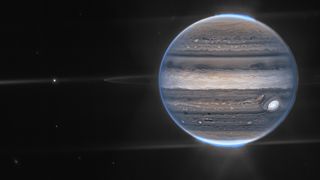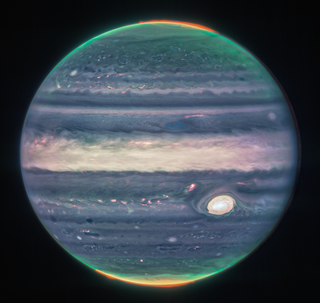Jupiter's auroras look radiant in new James Webb Space Telescope images
The impressive images were processed by a citizen scientist.

The James Webb Space Telescope has only been operating for several weeks, but it's already impressed with its early observations.
The newest release from the James Webb Space Telescope team is a pair of highly detailed images of Jupiter that show its auroras around the poles. Both images are composites, meaning they combine multiple images taken with the telescope's Near Infrared Camera (NIRCam) — each using a different filter — into a single, high-definition image.
In the wide-field image, you can see Jupiter's faint rings, as well as two of its moons: Amalthea is the bright dot on the far left, while Adrastea is the faint dot at the edge of the rings, located between Amalthea and Jupiter. Behind the three celestial bodies, the faint dots of light are suspected to be galaxies.
Related: NASA's James Webb Space Telescope mission: Live updates
"We hadn't really expected it to be this good, to be honest," planetary astronomer Imke de Pater, professor emerita of the University of California, Berkeley, said in a statement. De Pater led these Jovian observations with Thierry Fouchet, a professor at the Paris Observatory, as part of Webb's Early Release Science program. "It's really remarkable that we can see details on Jupiter together with its rings, tiny satellites, and even galaxies in one image," she added.
The second image is a close-up of Jupiter, which used three filters to capture the details of its stormy atmosphere, including the glowing auroras.
"The brightness here indicates high altitude — so the Great Red Spot has high-altitude hazes, as does the equatorial region," said Heidi Hammel, Webb interdisciplinary scientist for solar system observations and vice president for science at AURA. "The numerous bright white 'spots' and 'streaks' are likely very high-altitude cloud tops of condensed convective storms."
Get the Space.com Newsletter
Breaking space news, the latest updates on rocket launches, skywatching events and more!
You might be wondering why the colors of the images are not what we're used to seeing when it comes to Jupiter. Webb observes light in the infrared range, not the visible light range, so the colors of the two images are not the colors we observe with the naked eye. The infrared data has been mapped onto the visible light spectrum, so these images are "false-color," not "true-color."
Related: Jupiter, too! New James Webb photos show giant planet's rings, moons and more

And that brings about an interesting point about how Webb actually works. When Webb "takes an image," it's not actually snapping a photo and beaming it down to Earth — scientists only receive raw data that indicates brightness as measured by Webb's receptors. As such, scientists must process that data to create the images.
Typically that's done by the Space Telescope Science Institute (STScI), which is headquartered in Baltimore. But in the case of this pair of Jovian images, the data was processed by citizen scientist Judy Schmidt of Modesto, California. (For the wide-field image, she collaborated with Ricardo Hueso, a co-investigator on the observations from the University of the Basque Country in Spain.)
Schmidt and other citizen scientists often tap into publicly available data from space telescopes to process images — Schmidt processed her first image, taken by Hubble, more than 10 years ago. "I try to get it to look natural, even if it's not anything close to what your eye can see," Schmidt said in a statement.
The images, of course, are not just valuable for their aesthetic appeal. De Pater and Fouchet's research is intended to demonstrate Webb's capabilities for solar system science, including imaging bright sources and their faint counterparts (in this case, Jupiter and its moons). The team will also study "Jupiter's cloud layers, winds, composition, auroral activity, and temperature structure," as well as map the surfaces and atmospheres of Jovian moons Io and Ganymede, according to its mission page.
Follow Stefanie Waldek on Twitter @StefanieWaldek. Follow us on Twitter @Spacedotcom and on Facebook.
Join our Space Forums to keep talking space on the latest missions, night sky and more! And if you have a news tip, correction or comment, let us know at: community@space.com.

Space.com contributing writer Stefanie Waldek is a self-taught space nerd and aviation geek who is passionate about all things spaceflight and astronomy. With a background in travel and design journalism, as well as a Bachelor of Arts degree from New York University, she specializes in the budding space tourism industry and Earth-based astrotourism. In her free time, you can find her watching rocket launches or looking up at the stars, wondering what is out there. Learn more about her work at www.stefaniewaldek.com.
